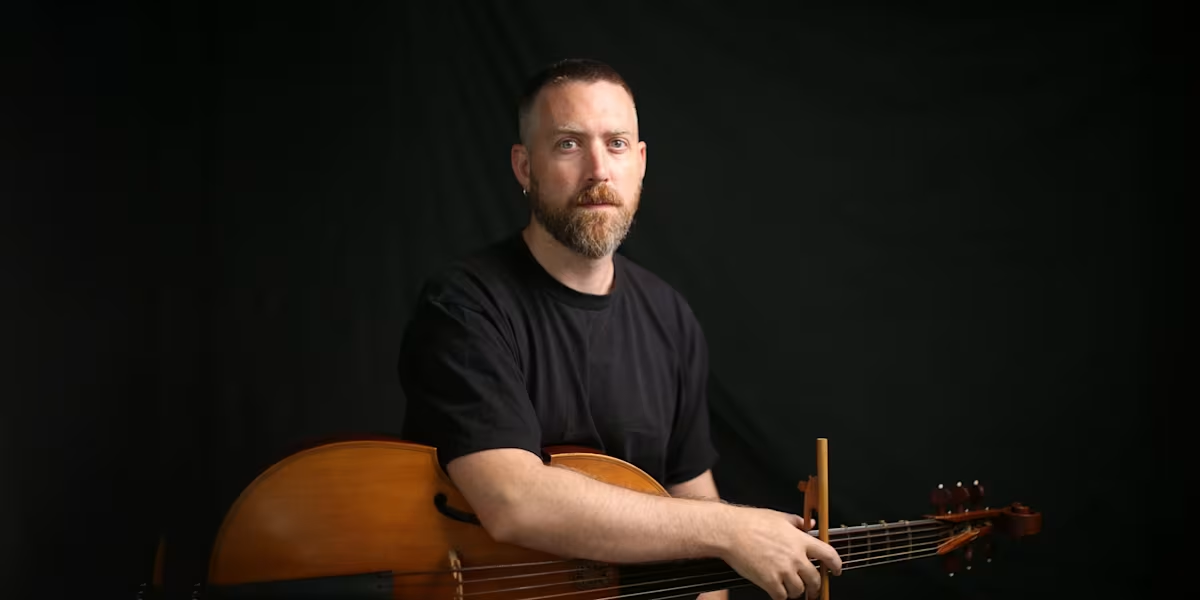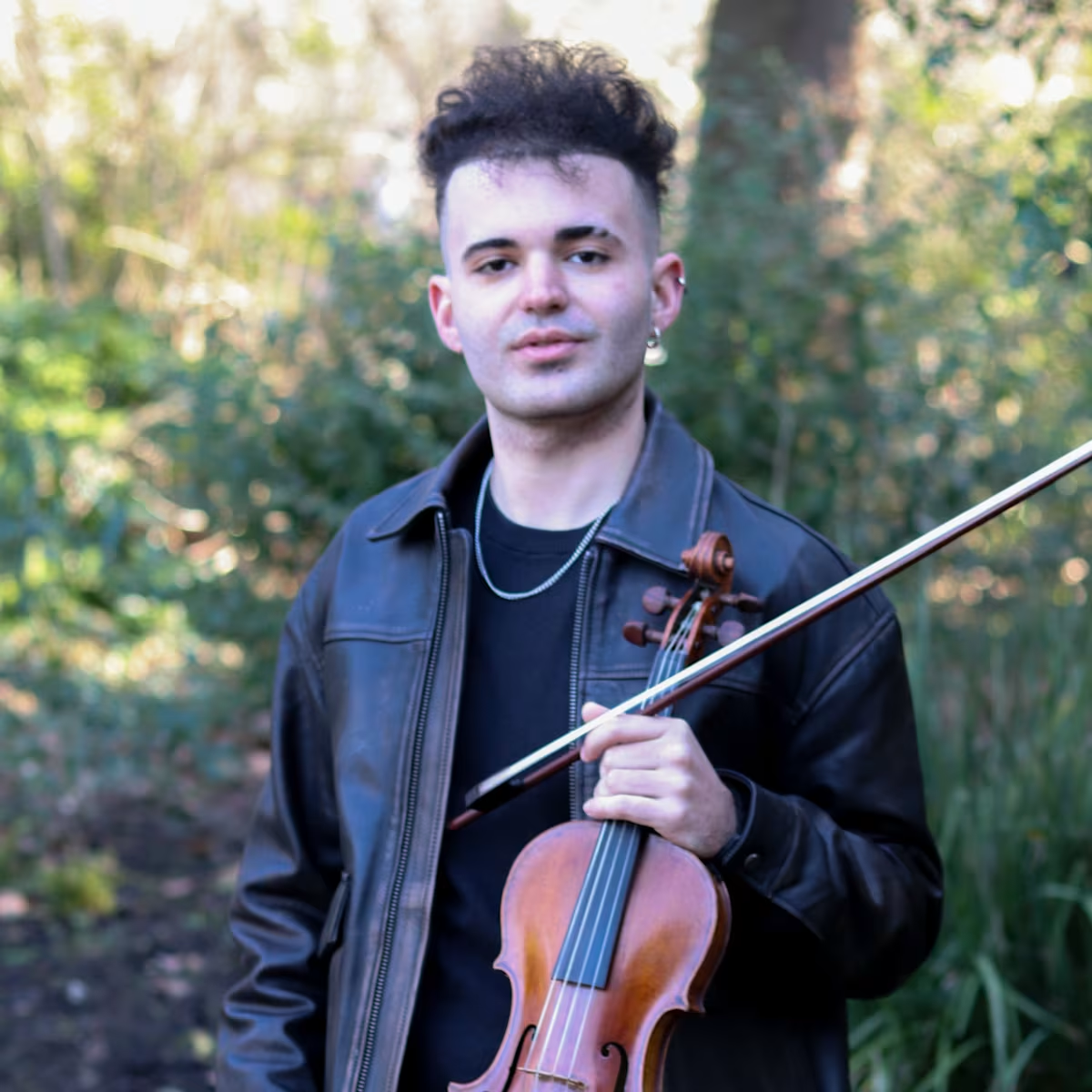Feature
Liam Byrne: New sounds for an old instrument
Share this

BY SIMON MUNDY | FIRST PUBLISHED 20 JUL 2025
The sentence that opens Liam Byrne’s description of himself on his website is succinct, but covers the territory. He, ‘spends most of his time playing either very old or very new music on the viola da gamba’. The story behind the statement has much more variety and nuance, however. With an Irish-American background, these days he is based in Berlin. ‘I did German at school, and fell in love with the city when I first visited at 18. I always imagined I’d live here at some point, but London called to me first.’
Liam’s early education was mostly in the States. At Indiana University in Bloomington, he began as a double bass player, but then started lessons on the viola da gamba with Wendy Gillespie, one of the founding members of Fretwork, who has taught there for 40 years now. After his time in the American Midwest, he came to Oxford to gather an MPhil, and began to explore the professional scene in England, part of which was following Gillespie into Fretwork.

Once into Fretwork’s network, he remained with them for four years, then took the unusual step for a viola da gamba player of going off on his own, without the backing of a consort group (though he has played as guest with many of the best ones). ‘I left Fretwork in 2014 and started commissioning new solo works, which really helped to establish my career. My interest in contemporary music led to a lot of exciting opportunities and gave me the freedom to grow artistically, especially as a soloist. Promoters often wanted me to play new music, but also usually gave me free rein to include whatever old music I wanted, which really deepened my understanding of historical repertoire as well.
‘When I first started playing the viol as a teenager, I was worried about closing myself off to new repertoire. But when I saw my teacher Wendy playing so much contemporary consort music, I realised the viol is very much still a living instrument, and that I didn’t need to give up playing new music in order to immerse myself in the old. Nowadays, more and more people are commissioning new works for old instruments, which is brilliant, but it’s important we remember that new music’s value is not simply in its newness.’
Liam Byrne performs Drones & Viola da Gamba by Nico Muhly
There is a great danger of ‘premieritis’, where a piece is commissioned but only performed at one festival or by its first musician. ‘Good work deserves to be played many times by many people, and I really want lots of viol players to play the works I’ve commissioned, and find new depth in them beyond what I’ve done at the premiere.’ Music, he points out, only enters the long-term repertoire when it has had multiple performers.
A big part of Byrne’s artistic development has been his work outside traditional concert halls. ‘I love working in museums and galleries,’ he says, and has worked with the National Gallery and Dulwich Picture Gallery, as well as the Victoria & Albert Museum. ‘My residency at the V&A was life-changing. I had a six-month stipend with a studio in the museum, all this time and space just to think artistically, with access to the entire museum as a performance space.
‘One day, I sat in the ceramics gallery unannounced and played the same Sarabande on repeat for three hours, just to see how it felt. Museums are magical, because people go with a lot of openness and curiosity, obliquely aware they’re going to see something old, but very willing to be surprised. The museum audience also has an immense amount of freedom and agency in shaping their journey. They can leave whenever they want, and as a musician, I love the genuineness of their responses, more honest and human than the formulaic conventions of the concert hall.’
Nadia Sirota & Liam Byrne perform ‘Letter O’ from Tessellatum by Donnacha Dennehey
Liam has also collaborated with musicians and artists beyond the realm of classical music altogether. Many of these collaborations have been groundbreaking, and he has been at the forefront of using the recording studio for works that go well beyond the usual boundaries. He is part of a collective based in Iceland, Bedroom Community, which has released, in addition to his debut solo album, Concrete (2019), ‘two massive studio-based works: Donnacha Dennehy’s 40-minute-long Tessellatum for multi-tracked viol and viola (with Nadia Sirota), and Sigurðsson’s Dissonance, a 23-minute deconstruction and explosion of Mozart’s C major String Quartet of the same name, using many layers of improvisation. At the moment, I’m working on an album of several of the unaccompanied pieces that have been written for me over the past decade.’
‘La voix humaine’ by Marin Marais and ‘Somnoptera’ by Valgeir Sigurðsson from Liam Byrne's debut solo album, Concrete
Liam’s life in Germany has been given a boost this year by being selected as the recipient of the Glenn Gould Bach Fellowship, with an award of €70,000 funded by the Philip Loubser Foundation and managed by the Thuringia Bach Festival. ‘All recording is an artificial construction, but in the classical world we often speak of it like it’s wildlife photography. Glenn Gould understood that you can use that artifice as an interpretative tool. My project focuses on early 17th-century lyra viol music, mostly Alfonso Ferrabosco II and his circle, trying to find an approach to recording that captures the incredibly unique way this music feels as a player.'
‘The music for the lyra viol is so much about the resonance and decay within the instrument’s body itself, like with lute music. The trouble with many traditional approaches to recording the viol is that they primarily capture the instrument’s resonance in the room and miss out what is happening in the instrument’s body. Here lyra viol music suffers disproportionately, which is what makes it an ideal repertoire for this experiment.’
Liam Byrne performs Almain in lyra way by Alfonso Ferrabosco II
Liam believes the new technological parameters of recording offer a fresh chance to explore the aesthetics of sound in the way music, old or new, is presented and that he can make his work a kind of case study that will be relevant to more than just other viol players. ‘I feel that broadly speaking there are a lot of musicians ready now for an aesthetic shift in the way we perform and especially record.’
Liam Byrne's album, Concrete (2019), is available to stream and download on Bandcamp, Apple Music and Spotify. Also enjoy our weekly Commute Playlist, this week featuring tracks from Byrne's album alongside some other tracks of contemporary music written for viola da gamba.
Share this
Keep reading

Hearing ‘The Four Seasons’ anew
Continuo’s Writer-in-Residence Simon Mundy catches up with broadcaster and musicologist, Dr Hannah French, about her book on Vivaldi and ‘The Four Seasons’.

In conversation: Joseph Lowe
Continuo catches up with violinist and violist Joseph Lowe to talk about his journey into Early Music and his recent video recording with the Lowe Ensemble.

Playlist: The Sacred Baroque
This playlist explores sacred music written during the Baroque period. It includes movements from masses, passions, oratorios and more.




